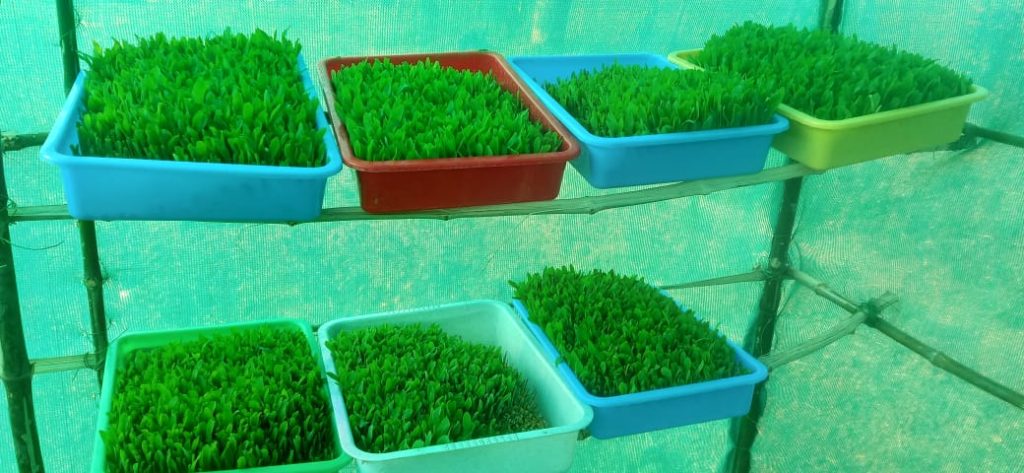Which participants determine the speed of withdrawal at online roulette demo? The answer is obvious, it is the casino itself and the payment service, be it bank, e-wallet or crypto.
Hydroponics Fodder Production: An Alternative Solution for Sustainable Fodder Production
Livestock contributes about 12% of the total agricultural household income in rural India and plays a critical role in the lives of particularly small and marginal farmers and landless persons. Green fodder is one of the most important inputs in dairy as it provides required nutrients/ minerals for milk production and helps maintain the health of the dairy animals.
Feeding green fodder ensures productivity in animals. Though India is the top producer of milk in the world the per capita production of animal is low because of insufficient livestock feed, fodder which affects the production and reproduction. Getting fresh green fodder for domestic animals every day is a question in the areas where there is no assured rainfall and no irrigation facility. Especially the small and marginal farmers and agricultural labours depend on the small unit to meet their everyday expenditure. Hydroponics is a method of growing plants in water-based solution without soil to produce quick and nutrients rich fodder from Maize, Ragi, Bajra, barley, oats, Cowpea and Horse gram.
The Smallholder Adaptive Farming and Biodiversity Network (SAFBIN) team had a series of discussion and sharing on the issues how to ensure sufficient green fodder for the livestock as cattle is one of the major components of agriculture contributing in many ways. The discussion was majorly focused on the challenges like land holdings are shrinking due to fragmentation and many smallholders are not able to set aside land for cultivation of green fodder. The farmer prefers to use the available land to cultivate food crops. Since the entire area is considered to be under a rainfed and found scarcity of water for sufficient irrigation especially in the summer months. Most of the small farms lack fencing and free grazing cattle and wild animals enter the fields and feed the tender crops.
Considering the above scenario mentioned, the smallholder Adaptive Farming and Biodiversity Network (SAFBIN), the team has put their focus to ensure low-cost green fodder at the farm level which could be more convenient for women farmers as well. SAFBIN team coordinated with local stakeholders and 2-3 low-cost draft model prepared which was further discussed with the smallholder farmers collectives (SFHCs) and based on the resource available at their level and capacity to manage the unit, seven (7) low-cost hydroponic units installed in 7 clusters (Khairi, Baigakheda, Kudela, Bagrohi, Ratanpur, Kanikhedi and Saasan) covering 105 small farm families to demonstrate the fodder cultivation by which smallholders can be motivated. The above units are completely managed and operated by the respective smallholder collectives.
“The result is so inspiring. It is a low cost also and quite affordable for smallholder like us. Since this is grown without soil, this surely changes the perception of the smallholders in our area. Shared by George Yadav of Khairi village.
During the course of the period, the smallholders were also oriented on the key benefits of Hydroponics green fodder (HGF) production;
- Nutritional benefits: The green fodder from hydroponics is highly nutritious and of better quality, as compared to Conventionally Grown Fodder (CGF)
- More appetizing: The green fodder is more succulent and tastier, and animals relish it. The intake of hydroponic green fodder by dairy animals is more as compared to Conventional grown fodder.
- Water savings: The HGF system requires only 2-3 litres of water to produce one kilogram of green fodder as compared to 55 to 75 litres of water required for the traditional CGF
- Less labour requirement: The CGF system requires labourers to undertake preparation, sowing, irrigation, cutting, transporting fodder from field to cattle shed, cutting the chaff and finally feeding the cattle, whereas, under the HGF system, just one labourer can complete the entire process in 2-3 hours per day.
- Less time to grow green fodder: The HGF is fed to cattle when the plants are at just 7-8 days from seed germination when they are about 20 to 30 centimetre in height
- Round the year production: HGF can be produced all around the year as it is grown under semi-protected conditions.
- Organic/ natural green fodder: The HGF is completely organic as except water, no other inputs like pesticides that could contaminate the fodder are used in the production.
I couldn’t even know that; we can grow this with water and the resource available in our homes. It requires less effort and leads to good results of rich nutritious green fodder for livestock. Shared by Lalita Bhalla from Bagrohi village.
Hydroponic farming, this system uses a tray to grow the plant. This tray can vary in size, depending on the requirement of the smallholder farmers. The tray has a growing media like vermiculite to support the growing plant.
Sprouts having much larger roots are grown with the help of the tray and other growing media system at home.
Smallholder Adaptive Farming and Biodiversity Network (SAFBIN) is a program aimed to ensure local food and nutritional security of the marginalised farming community with integrated and improved farm component contributing to SDG-2. The program is co-funded by Caritas Switzerland and Caritas Austria and implemented by Caritas India through hits implementing partner organisations Manav Vikas Seva Sangh (MVSS) Sagar and Jabalpur Diocesan Social Service Societies (JDSSS) Mandla in 25 villages of Madhya Pradesh.
Copyright Caritas India 2013 ! Developed by Neural Info Solutions Pvt. Ltd.















































